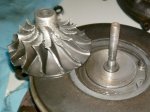martinv
Member
- 50
- 58
- 18
- Location
- Glyndon MN
The turbo came out without much problem. Just needed about 16" of leverage for the exhaust bolts.
It looks like I found a used turbo i'm likely purchasing now, but still wan't to investigate and possibly repair the one I have.
The harder part to disassemble is getting the cartridge assembly out of the exhaust side:
Yellow arrow shows the rusted seam. Red arrow is a ledge that circles the unit where I tried hammering (regular, then impact) with a chisel hoping the vibration would break down the rust. No luck so far. Seam is soaking in WD40 now.

Compressor wheel doesn't look so good:

It looks like I found a used turbo i'm likely purchasing now, but still wan't to investigate and possibly repair the one I have.
The harder part to disassemble is getting the cartridge assembly out of the exhaust side:
Yellow arrow shows the rusted seam. Red arrow is a ledge that circles the unit where I tried hammering (regular, then impact) with a chisel hoping the vibration would break down the rust. No luck so far. Seam is soaking in WD40 now.

Compressor wheel doesn't look so good:

Last edited:

